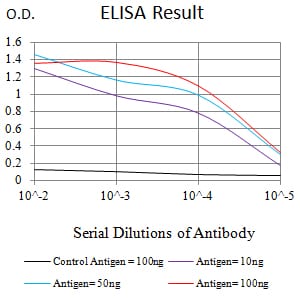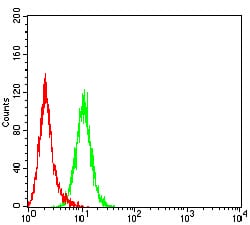

| WB | 咨询技术 | Human,Mouse,Rat |
| IF | 咨询技术 | Human,Mouse,Rat |
| IHC | 咨询技术 | Human,Mouse,Rat |
| ICC | 技术咨询 | Human,Mouse,Rat |
| FCM | 1/200 - 1/400 | Human,Mouse,Rat |
| Elisa | 1/10000 | Human,Mouse,Rat |
| Aliases | ILT2; LIR1; MIR7; PIRB; CD85J; ILT-2; LIR-1; MIR-7; PIR-B |
| Entrez GeneID | 10859 |
| clone | 4B5A4 |
| WB Predicted band size | 70.8kDa |
| Host/Isotype | Mouse IgG1 |
| Antibody Type | Primary antibody |
| Storage | Store at 4°C short term. Aliquot and store at -20°C long term. Avoid freeze/thaw cycles. |
| Species Reactivity | Human |
| Immunogen | Purified recombinant fragment of human LILRB1 (AA: extra 338-461) expressed in E. Coli. |
| Formulation | Purified antibody in PBS with 0.05% sodium azide |
+ +
以下是3篇关于LILRB1抗体的代表性文献摘要:
---
1. **文献名称**:*LILRB1 interacts with MHC class I to limit T cell function in anti-tumor immunity*
**作者**:Barkal, A.A. et al.
**摘要**:研究揭示LILRB1通过识别肿瘤细胞表面的MHC I类分子抑制T细胞活性,开发靶向LILRB1的抗体可阻断此通路,增强CD8+ T细胞的抗肿瘤免疫反应。
2. **文献名称**:*Antibody-mediated blockade of LILRB1 reverses HIV-1 latency*
**作者**:Chen, J. et al.
**摘要**:实验证明LILRB1抗体可干扰其与病毒蛋白的相互作用,解除对免疫细胞的抑制,促进潜伏期HIV-1的激活,为清除病毒储存库提供新策略。
3. **文献名称**:*LILRB1 regulates inflammatory responses in macrophages via interaction with SHP-1*
**作者**:Deng, M. et al.
**摘要**:研究发现LILRB1抗体通过阻断其与SHP-1磷酸酶的结合,抑制巨噬细胞中促炎细胞因子(如TNF-α、IL-6)的释放,缓解类风湿性关节炎模型症状。
---
如需更多文献或扩展方向(如抗体结构优化或临床前试验),可进一步补充说明。
LILRB1 (Leukocyte Immunoglobulin-Like Receptor B1), also known as CD85j or ILT2. is an inhibitory receptor belonging to the leukocyte immunoglobulin-like receptor (LILR) family. It is primarily expressed on myeloid cells, including monocytes, macrophages, dendritic cells, and subsets of lymphocytes. LILRB1 binds to MHC class I molecules and other ligands, such as ANGPTLs, to deliver inhibitory signals through immunoreceptor tyrosine-based inhibitory motifs (ITIMs) in its cytoplasmic domain. These signals dampen immune activation, regulate inflammatory responses, and contribute to maintaining immune tolerance, but they can also be exploited by tumors or pathogens to evade immune detection.
Antibodies targeting LILRB1 aim to block its immunosuppressive function, thereby enhancing anti-tumor immunity. In cancer immunotherapy, LILRB1 inhibition may reverse T-cell exhaustion, promote antigen presentation, and synergize with checkpoint inhibitors (e.g., anti-PD-1/PD-L1). Preclinical studies suggest that LILRB1 blockade can reactivate myeloid cells in the tumor microenvironment, reducing immune evasion. Additionally, LILRB1-targeting antibodies are explored in infectious diseases to boost pathogen clearance.
Current research includes monoclonal antibodies and bispecific molecules in early-phase clinical trials. Challenges include balancing efficacy with autoimmune risks and optimizing target engagement in specific cell populations. LILRB1 remains a promising but complex therapeutic target in immuno-oncology and beyond.
×